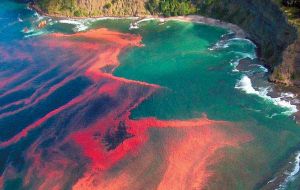MercoPress. South Atlantic News Agency
Chilean scientist develops kit to detect toxic algae bloom
 Red tides or Mareas rojas
Red tides or Mareas rojas Although shellfish poisoning is not that common in Chile, it does occur frequently as a result of mysterious, massive algae blooms – the so-called “red tide” phenomenon.
Although scientists have known about the red tide for centuries, they are still unclear why the algae blooms occur. Research in Chile is aimed at developing new technology to predict when future blooms will occur. "The exact reasons for red tides are still unknown," Universidad de Católica Research Doctor and Microbiologist Mónica Vásquez told the Santiago Times. "There are many factors controlling it, which make it very unpredictable. In Chile, it occurs on average twice a year, mostly between November and April." "Red tides" or "Mareas rojas" can lead to considerable economic losses in Chile and create a public health risk. Vásquez is now developing a kit to help predict the sporadic blooms. Red tides are caused by small seawater organisms, called phytoplankton, which suddenly multiply and form large "blankets" on the surface of the water. These blankets can be red, brown, green or even colorless, depending on the phytoplankton species. Though not all red tides are necessarily dangerous, the microorganisms in the tide oftentimes produce a toxin harmful to both people and wildlife. For humans, the toxic fumes produced by the algae blooms can provoke respiratory problems and irritate the skin. Still, ingestion of the blooms can be very dangerous. Bivalves, such as oysters and clams, filter the water for nutrients and thereby accumulate the harmful microorganisms in their tissue during red tide episodes. When humans eat these delicacies with high levels of toxins, they run the risk of suffering from a life threatening disease called paralytic shellfish poisoning. Vásquez has been studying Chile's red tides the past 10 years, learning how to track them. This week she is giving a speech and leading discussion in Puerto Montt (Region X) about her latest research on the subject - research that may become extremely beneficial to Chile and other countries that depend on large seafood industries. Vásquez and her colleagues are studying the microorganism genes in order to design a prediction mechanism. If they identify the exact amino acid sequence that signifies potentially dangerous algae, they can look for this unique sequence when they screen a water sample. "Currently, water analysis is complicated and takes a very long time. The idea is to design a kit that is easy to use and gives quick results," said Vásquez. Methodology now used to test toxins levels in shellfish is another issue Vásquez is addressing. Currently, control labs inject mice with an extract taken from suspect shellfish. If the mammal dies within five minutes, the toxin level in the shellfish is too high. "In Europe, the test is first performed chemically and then afterwards on mice, only if there is reason to suspect high levels of toxins. But in Chile, this method is too expensive," said Vásquez. As a result, Chile uses 60,000 mice each year for testing purposes. The waters around Region X's Puerto Montt and Chiloé are Chile's main source of shellfish. Because controlling agencies are understaffed, toxic shellfish can sometimes make their way to restaurants or seafood markets. Fishermen are among those most affected by the harmful algae blooms. Oftentimes they are not aware of a red tide episode until it is too late, and several days of work must be discarded, creating considerable losses. The red tide in Chile is colorless and only a water sample analysis will reveal if the amount of toxins are above the level that causes intoxication. "Getting the analysis too late is a big problem here," said Vásques. "Hopefully, our detection kit can help notify fishermen well before a red tide episode occurs, so they have time to make decisions about going to fish somewhere else." Vásquez reaffirmed that there are big problems obtaining frequent tests. "There are not enough people to monitor and there are frequent logistical problems, because there are not enough boats around," she said. Fish markets in Santiago claim that red tide toxins do not affect their products. "Our goods are controlled regularly and we have a lot of confidence in this system," said Eliana Morales, a fish vendor at Santiago's largest seafood market, El Mercado Central. Morales, a 20-year veteran of the Santiago fish market scene knows that people are aware of potential problems. He says Santiago's fish market feels the effects after media announcements of the toxic algae blooms. "When people hear that there is a red tide in Chile, our customers ask more questions about shellfish, and sales tend to go down." The economic losses due to these harmful red tides are enormous, not only to Chile, but in other countries around the world, including Argentina, the United States, Japan, and Spain. Chile loses approximately US$10 – 50 million a year while and the state of Florida in the U.S. loses roughly US$45 – 50 million. The Santiago Times




Top Comments
Disclaimer & comment rulesCommenting for this story is now closed.
If you have a Facebook account, become a fan and comment on our Facebook Page!